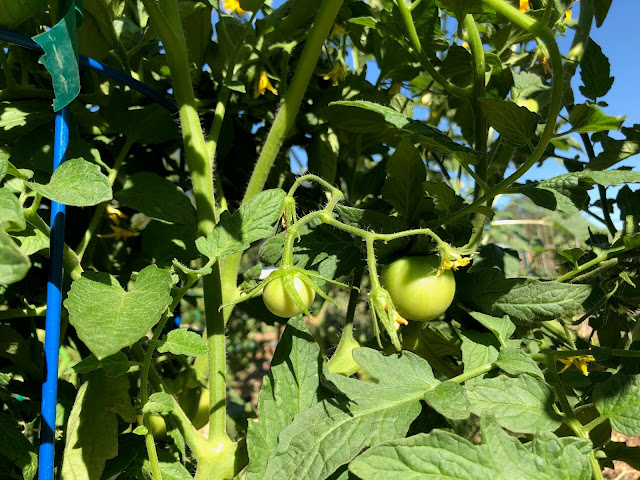
|
|
This tomato plant might drop its flowers in the next several hot days, but there are measures a gardener can take to save the tomatoes already growing. (Photo: Kathy Morrison)
|
How to help your tomatoes cope with triple-digit temperatures
Tomatoes don’t like high heat any more than people. When temperatures hit a string of days in the high 90s or hotter, tomato production becomes problematic.
If this coming week follows its forecast, expect a gap in your harvest later this summer.
According to the National Weather Service, Sacramento starts summer with a heat wave. Highs for every day until June 28 are forecast 95 degrees or higher, with four days expected to top 100.
Which means tomatoes will drop their flowers instead of setting fruit. Even heat-tolerant varieties won’t set tomatoes in such high temperatures.
Once temperatures cool down to the mere 80s, the vines likely will try again and send out more flowers, hopefully yielding late-season tomatoes.
The trick now is to preserve the crop that’s already on the vines. If planted in March or April, vines likely have several green tomatoes. What you do this week will determine their fate.
1. Mulch. If you haven’t already, spread a 2- to 3-inch blanket of straw, leaves or other organic mulch around your tomato plants. It keeps the soil – and roots – cooler and more comfortable. Mulch also helps the soil retain moisture longer and cuts down on weeds.
2. Weed. Many invasive plants thrive in this heat and grow rapidly, competing with your tomatoes for space, water and food. Eliminate weeds and your tomatoes will be happier. But be gentle when removing weeds; avoid disturbing the tomato plant’s roots.
3. Deep water; don’t overwater. Tomatoes benefit from a good soaking once or twice a week instead of a little water every day. Not enough or inconsistent moisture levels can lead to cracked tomatoes or blossom end rot, which looks like a dark brown or black lesion on the bottom of the fruit. (Blossom end rot has nothing to do with rotting flowers.) Avoid letting soil dry out completely. But the soil shouldn’t be kept wet; that can suffocate roots. Before watering, look at the soil. Test it with a moisture meter or just poke your finger in and feel.
4. Skip the fertilizer. Don’t feed tomatoes during a heat wave. Fertilizer can cause leaf burn if not enough moisture is present in the soil. Nitrogen now will just stimulate more vine and leaf growth – not fruit. The result is a weak and spindly plant prone to disease and insect infestations.
5. Think about shade. Too much sun can cause sunburn on the shoulders of ripening tomatoes. If your vines are getting blasted by afternoon sun, erect a temporary shade structure with burlap, cardboard, nursery flats or other lightweight materials.
6. Consider picking tomatoes before they’re red. It’s heresy to pick homegrown tomatoes before fully ripe, but some large tomatoes (particularly beefsteaks) will not turn red when temperatures stay hot. They’ll get orange, but not crimson. Pick the big orange ones and let them turn red on your kitchen counter. They may not have the same intense flavor as fully vine-ripened, but they’ll still be good, red and ready in a week instead of waiting until the weather cools down.

